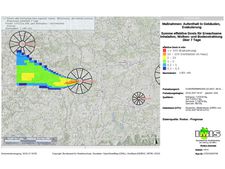-
Topics
subnavigation
Topics
Electromagnetic fields
- What are electromagnetic fields?
- Static and low-frequency fields
- Radiation protection relating to the expansion of the national grid
- High-frequency fields
- Radiation protection in mobile communication
Optical radiation
Ionising radiation
- What is ionising radiation?
- Radioactivity in the environment
- Applications in medicine
- Applications in daily life and in technology
- Effects
- What are the effects of radiation?
- Effects of selected radioactive materials
- Consequences of a radiation accident
- Cancer and leukaemia
- Genetic radiation effects
- Individual radiosensitivity
- Epidemiology of radiation-induced diseases
- Ionising radiation: positive effects?
- Risk estimation and assessment
- Radiation protection
- Nuclear accident management
- What happens in an emergency?
- Federal and state tasks
- In the event of an emergency
- Protection of the population
- Radiation exposure
- Psychosocial consequences
- Decision support systems
- Measuring networks
- Exercises for emergency situations
- Nuclear accidents
- Defence against nuclear hazards
- Service offers
-
The BfS
subnavigation
The BfS
- About us
- Science and research
- Laws and regulations
- BfS Topics in the Bundestag
- Links
Decision support systems RODOS
Decision support: Calculation and mapping of radiological impacts
- The prognosis and decision support model RODOS ("Realtime Online Decision Support System") calculates the future environmental contamination and the expected doses to the affected population in a radiological emergency.
- RODOS is a part of the Integrated Measurement and Information System (IMIS) of the Federal Office for Radiation Protection (BfS).
In the event of an emergency, it is vital to immediately make reproducible predictions on the radiological situation. The decision support model RODOS ("Realtime Online Decision Support System") within the Integrated Measurement and Information System (IMIS) is available for this purpose.
The future environmental contamination and the expected doses can be estimated with the help of RODOS. These predictions form the basis for specific emergency response measures, such as evacuating the population which may be imposed by the competent authorities.
RODOS results are used in the "Federal Radiological Situation Center" to assess the situation and recommend protective measures.
What does RODOS calculate?
RODOS calculations are based on forecasts of the Deutscher Wetterdienst (German Meteorological Service) and on measurement values which are routinely collected at German nuclear power plant sites and continuously transferred to the RODOS model.
On this basis, the model determines the radiation exposure of humans after a release of radioactive material into the environment. Human radiation exposure is composed of the following constituents:
the external exposure of humans to
as well as of the internal exposure
- due to the intake of radionuclides through breathing and
- through food.
RODOS also calculates potential contamination of foodstuff and forage of food and feed.
Presentation of results and derived measures
The predictions of the environmental contamination and of the expected radiation exposure of humans calculated by RODOS are visualised in result maps. The expected radiation exposure levels are displayed colour coded from red through orange (particularly high exposure) to dark blue (slight exposure).
The following figures show examples of RODOS predictions. They were modelled as part of an exercise.
Example 1

![]() RODOS calculation decision support for the civil protection measures sheltering and evacuation. The map also shows the disaster control circles with twelve sectors for each nuclear power plant.
RODOS calculation decision support for the civil protection measures sheltering and evacuation. The map also shows the disaster control circles with twelve sectors for each nuclear power plant.
Areas requiring measures for the protection of the population due to the anticipated time of release and the amount of radioactive material released are shaded red and orange in the map example. Specific measures, which may be imposed by the competent authorities, can be allocated to the colour values.
The colour red in this example means that the people living in that area will have to be evacuated because of the expected high radiation levels.
People living in the orange shaded areas should temporarily stay in closed rooms for their own safety.
No direct measures are required in the areas shown in yellow, green and blue.
Example 2

![]() Contamination of leafy vegetables with radioiodine.
Contamination of leafy vegetables with radioiodine.
RODOS also calculates the potential contamination of food and feed. The second map example illustrates a map showing the contamination of leafy vegetables with iodine-131. The colours are chosen based on the limit value of 2,000 becquerels of radioactive iodine per kilogram of leafy vegetables set by the European Union (EU).
The map shows the affected areas and the anticipated contamination levels.
In the areas coloured from dark blue to yellow, the potential contamination of the vegetable is below the EU limit value.
The limit value is exceeded in the areas shown in orange and red. In such areas, measures such as covering or prematurely harvesting almost ripe products might perhaps help to keep contamination as low as possible.
If a release of radioactive material actually occurs and the measured values exceed the EU limits, the vegetables grown in those areas must not be marketed. The authorities impose a "marketing ban" as a measure taken in this case.
State of 2018.03.19


